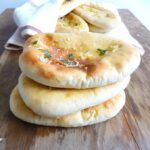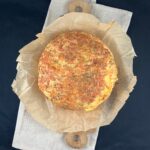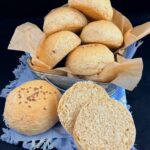Spelt Garlic Butter Naan Bread
These spelt naan breads are light and fluffy, topped with fragrant garlic butter. The dough can be prepared in either a bread maker or stand mixer (or even by hand), and the spelt flour can be swapped out for bread or all-purpose flour.

This spelt garlic butter naan bread was originally published on The Culinary Jumble. The recipe has been updated to include spelt flour.
Jump to: |
| What is naan bread? |
| Authentic naan bread |
| What can I serve naan bread with? |
| Can I make the dough in a bread machine? |
| Other spelt dough recipes |
What is naan bread?
One of the best things on the planet. That’s what. No exaggeration. Naan tastes good in its own right, but when dunked into rich curry sauce, well, that’s heaven on a plate, right there.
Although most often attributed to Indian cuisine, Naan bread is the umbrella term for leavened (and sometimes, unleavened) bread popular across South Asia. The bread is cooked in a tandoor oven, which allows the edges to scorch and crisp up beautifully, while the middle of the bread remains light and fluffy.
The first recorded mention of naan bread dates back to 14th century Delhi. At the time, it was noted as being bread for kings. Back then, naan bread was only eaten by the upper echelons of Indian society. Four centuries later, and things had changed substantially. Records state that at the beginning of the 19th century, naan bread was no longer restricted to just the upper class. In 1810, the first Indian restaurant opened its doors in London, but naan bread had been eaten (and talked about) by Westerners way before that.
Authentic naan bread
I am going to start off by saying that this recipe for naan bread is not authentic. For starters, I don’t have a tandoor clay oven. Plus, there isn’t only one authentic naan, as the recipe varies from place to place. That being said, a plain traditional naan bread is invariably made with wheat flour, yeast (or baking powder) and water. Sometimes, yoghurt is added, and this naturally changes the taste and texture, yielding a fluffy bread.
Naan bread can have many different fillings and toppings. This recipe has minced garlic mixed with butter and liberally spread over the top of a warm plain naan. Keema is naan bread stuffed with spicy ground meat. You can also have sweet naan bread, too: Peshwari is filled with almonds, dried fruit and coconut.
Anyway, let’s get back to this recipe for spelt naan bread. This is my go-to dough. It’s a recipe I use time and time again. Because it works. I use it for naan, too. Obviously. My base dough includes butter and eggs, and as already highlighted above, additional ingredients will make the bread richer than more traditional versions. It certainly won’t taste like those they dish up at your favourite curry house. But, with pillowy, soft bread and aromatic garlic butter, you won’t much care.
What can I serve naan bread with?
Naan bread is the quintessential side for Asian-themed dishes like simple butter curry or garlic coconut chicken curry. But there are so many other ways you can enjoy a fluffy naan:
- Dip it into a thick, homemade soup, like spicy roasted tomatoes or roasted cauliflower and red pepper
- Enjoy it as a side to a crispy feta cheese salad
- Make it into a naan bread pizza by adding chili tomato sauce and your favourite toppings
- Top it with cheese and make cheese on toast, or sandwich two together to make grilled cheese
Can I make the dough in a bread machine?
Yes, absolutely. I’ve talked before about how my bread making was revolutionised by a simple bread machine. However, after I got my stand mixer, the once beloved bread maker found itself stuffed in the back of the cupboard for a few years. I recently dug it out and remembered why I’d like it so much in the first place. I’ve made a heck of a lot of dough using both methods, and overall, have found very little difference in the end results. In my recipe post for hot dog buns, I talk more about the positives and negatives of both methods.
Of course, there is a third option. You could always make the dough by hand. If you like that kind of thing. I don’t. I have some texture issues, and kneading dough by hand really bothers me.
Other spelt dough recipes
My base recipe for bread doesn’t change much at all. I just adapt it by adding sugar, spices a little zest or a touch of olive oil. Here are some of my favourites:
- Spelt crust pizza with homemade sauce
- Cardamom bread
- Coffee cinnamon buns
- Lime sweet bread
- Spelt subway buns
- Cinnamon swirl bread
Spelt Garlic Butter Naan Bread (from scratch)
Ingredients
Dough (see note 1):
- 250ml (1 cup) milk
- 50g (3½ tbs) butter
- 1 egg (medium)
- 400 - 450g (3⅓ - 3¾ cups) spelt flour (see note 2)
- 7g (2¼ tsp) dried yeast (see note 3)
- 2 tsp sea salt
- 1 tbs sugar
- ½ tsp garlic powder
- ¼ tsp dried coriander
Garlic Butter
- 30g (⅛ cup) butter
- 5 garlic cloves (crushed)
- sea salt
- fresh coriander (chopped)
Instructions
DOUGH
Bread Machine:
- Add the milk, butter and egg to your bread machine pan.
- Then add 400g (3¼ cups) of flour, and the remaining dough ingredients, taking care to keep the yeast and salt separate as much as possible.
- Set your machine to make dough.
- On a very well-floured surface (the dough will be very sticky) work in just as much flour as you need to make a soft, pliable, but still a little tacky, dough.
Stand Mixer:
- Add the milk, butter and egg to your stand mixer bowl, and mix together. If the butter is straight out of the fridge, it won't combine with the other wet ingredients too much, but that's okay.
- Add 450g (3¾ cups) of flour, and the remaining ingredients. The dough should be sticky, but if you need more flour, just add a little at a time. Be careful: too much flour will result in dry bread.
- Switch to a dough hook (if you have one) and allow the mixer to knead the dough for around 5 minutes, just until soft. The dough will still feel a little tacky to the touch, but will be able to slowly drop off the hook.
- Cover the dough and leave to proof (until it has doubled in size - usually about an hour).
- When the dough is ready, knock it back, and on a well-floured surface (adding more flour if you need it) quickly knead into a rough ball.
For both methods:
- When the dough is ready, pre-heat the oven to 225°C (437℉) and line one or two large baking trays with parchment paper.
- Divide the dough into eight fairly equal amounts.
- Take each one, and using your hands, roll into a rough ball.
- Roll each ball out (with a rolling pin) so that the length is slightly longer than the width (see note 4).
- Repeat with the remaining seven dough balls, and place onto the prepared trays allowing space between them.
- Cover with a tea-towel and let them rest again for around 15 minutes.
- Bake for around ten minutes (they are ready when dark brown spots start to appear).
- Remove from the oven, cover with a tea-towel and gently push down on them so that any air escapes. Be careful: the steam is hot.
Garlic butter:
- Mix the softened butter with the crushed garlic.
- Brush or spread over the warm bread, sprinkle with sea salt and a little fresh coriander.
- Serve while still warm (keep them covered until ready to eat). Enjoy!
Notes
- I have made the dough using both a stand mixer and bread machine with identical results. I have not made the dough by hand, but I see no reason why you couldn't do so!
- You can use spelt or regular flour for this recipe (just use the same amount).
- In Sweden we have something called dried yeast. It is used both in warm liquid to proof and also added directly to flour. I am aware that the US has two options for dried yeast, and I believe instant yeast is the most similar for the purpose of making this particular bread.
- The size and thickness will vary depending on personal preference: the thicker the dough, the fluffier the naan will be. Baking time may also vary depending on the thickness (you might need to keep thicker naan in the oven for a little longer).
3 thoughts on “Spelt Garlic Butter Naan Bread”
Leave a Reply







I made these tonight and we absolutely loved them. Fluffy, tasty – totally glorious.
I found the dough to be very sticky which made them difficult to roll.
Also do you have any tips for what I could replace the egg with to make it vegan ?
Thanks so much for the recipe.
Hi Lisa! So glad you liked them – we do, too! I deliberately keep the dough sticky so that the bread is lighter. To make things easier, I just use tonnes of flour when handling the dough. I will go back to the recipe to make sure readers are aware of this from now on, so thank you! As for the egg, you could just omit it (and perhaps use a little less flour to compensate for less liquid!